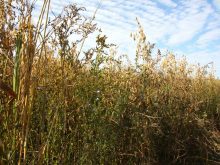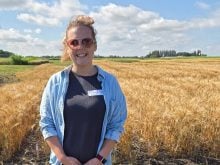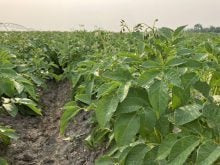Rice in Manitoba was a disaster. In 2012, in the Banana Belt region of the province near Melita, the staff at the Westman Agricultural Diversification Organization (WADO) seeded a plot of dry rice to see if they could bring it to harvest.
The project fit with their role in Manitoba’s agricultural sphere: They risk the wreck, so the farmer doesn’t have to.
Why it matters: Manitoba has four diversification centres, in Melita, Roblin, Carberry and Arborg, that test crops and practices that are new or require more data to optimize their utility on the farm.
Read Also

Manitoba boosts stake in cereals centre to $20 million
Premier Wab Kinew said the additional project funds will help ‘Trump-proof’ the provincial economy.
If it had worked, Manitoba might have added another staple crop to rotations. Researchers thought the unique weather trends and characteristics of the region had provided success to other unusual crops, so maybe rice could also make the jump.
It didn’t turn out that way.
“It was the end of May,” said Scott Chalmers, WADO’s applied research specialist. “It took two weeks before it even decided to come out of the ground, and that’s way too long. You want to see crops come out of the ground, or at least germinate, within three days.”
The rice experiment is one of many examples in which Manitoba’s diversification centres have pushed the province’s agricultural boundaries.
As well as variety trials for mainstream crops or research on input application, the sites have tested best practices for hemp or potatoes and researched the viability of quinoa. WADO has looked extensively into intercropping combinations and the agronomy for established intercrop combinations like peaola.
Chalmers estimates that, across the four provincial crop diversification centres, about 145 crops have been tested. Some of those, like rice, have been losers, but others, like hemp, passed muster and can now be found in fields across the province.
Diversification
Diversification boils down to the idea that “you shouldn’t put all your eggs in one basket,” Chalmers said. “This has to do with rainfall, heat and cool conditions and the different environmental risks that we have to buffer ourselves against.”
More crops in the rotation means more biodiversity on the farm and more time between crops that share a disease or pest profile, muting the risk of compounding issues year after year.
It also means more markets, increasing economic resilience and opportunity for growth for the farm and for Canadian agriculture as a whole.
Manitoba has more than 11 million acres of working cropland and 97 per cent of it is covered by just 11 crops. Over half of that is wheat and canola. An additional 25 per cent goes to soybean and tame hay, with the remainder in oats, barley, corn and a few others.
About three per cent, or close to 846,000 acres, is dedicated to specialty crops like sunflowers (Manitoba accounted for the bulk of Canadian production as of the 2021 census), potatoes, flax and hemp.
Hemp
Hemp’s success story has a number of roots. The crop grows well under Manitoba conditions, producing both grain and oil that have become mainstay markets for local hemp growers. It’s been helped by the rise of local processors and end users like Manitoba Harvest.
Consumer interest in plant-based protein also set the stage for hemp’s market potential. High protein content is a major trait of the grain.
The legalization of cannabis and subsequent loosening of hemp regulations was, at one time, another source of excitement for the industry. The changes were expected to open the nutraceutical market, with hemp as a source of CBD, a compound that can be derived from both hemp and cannabis. CBD is said to have many health and wellness attributes.
But the industry ran into logistical challenges with processing and marketing hemp for that use, and hemp for CBD production stalled.
“We’re also looking at the fibre and its multiple uses that boost the value,” Chalmers said. “We’re looking at things like the woody hurd portion, which is used in cement to reinforce it and add insulating R value, as well as the fibre, which can be used in composites for things like making doors for vehicles.”
Today, Hemp Sense in Gilbert Plains is a major processor of hemp fibre in Manitoba. It focuses on livestock bedding, kitty litter and animal feed, and it has also made inroads into the human food market.
Making it work
The work at WADO often focuses on agronomics to ease production of new crops, but there are many non-agronomic factors that affect whether a novel crop will join the winner’s circle.
There is the equipment variable. What kind of machines are needed to grow and harvest the crop, and is there a local mechanic able to fix or maintain that machinery?
Is there a financial institution that understands the crop’s risk and value, and will lend money to grow it?
Is there a grower’s organization to help finance breeding programs and offer agronomic extension or marketing information? Is transportation to a processor or buyer economically viable?
“Hops have been, by far, my favourite endeavour,” Chalmers said. “Randy Tye and his wife, Lynn, started a hop yard south of Boissevain a few years back. They were able to harvest eight acres with a yield of about a thousand pounds per acre, dry.”
The local producers were able to sell all the hops to microbrewers in Manitoba.
“The challenge was that this crop is very thirsty and it’s labour intensive,” Chalmers recalled. “It’s also a magnet for insects like the two-spotted hop aphid, which is native to Manitoba and found in chokecherries. Hops require intensive spraying with a fogger.”
In another example with less positive results, a Dutch company tried to jumpstart Manitoba production of calendula, a perennial plant in the daisy family. The company was attracted to Manitoba due to lower land prices and hoped to produce calendic acid-rich oil from pressing the crop’s seeds. That oil would have been a base ingredient in wood lacquer for furniture finishing.
“We took it to a cold press and tried to get some of the oil out and they almost broke the press,” Chalmers said. “The company gave up, and we really didn’t hear too much about this after that.”
Up and comers
Manitoba now has a number of promising novel crops under review. One is teff, an African grass with an edible seed. The grain shows promise for flat breads, while the stalk can be used as livestock fodder.
Another is lupin, a bean crop native to the Mediterranean and Eurasia that has good protein content and nitrogen fixation. That crop has earned national investment from Canada’s protein supercluster, Protein Industries Canada, elsewhere on the Prairies.
In 2022, $7.3 million was announced for four companies: Calgary-based Lupin Platform; Hensall Co-op; Lumi Foods; and Puris, to develop the crop and improve its processing and market.
At WADO, lupin has been a feature of test plots for several years.
“We’re all part of this value chain where it all starts out with a unique idea and it filters down through the research continuum to the applied research,” Chalmers said. “But most importantly, you have to do extension so you can transfer it to the end users who are adopting it on the field.”















